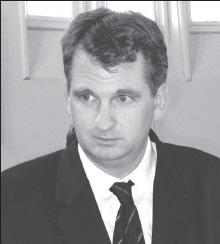
 In his most
recent book Bloodlands: Europe Between Hitler and Stalin, presented at St.
Vladimir Institute in
In his most
recent book Bloodlands: Europe Between Hitler and Stalin, presented at St.
Vladimir Institute in Nazi, Soviet Killing Policies Presented in Bloodlands
By John Pidkowich

 In his most
recent book Bloodlands: Europe Between Hitler and Stalin, presented at St.
Vladimir Institute in
In his most
recent book Bloodlands: Europe Between Hitler and Stalin, presented at St.
Vladimir Institute in
The presentation
of Bloodlands was sponsored by the Polish Cultural Institute (NYC), Ukrainian
Jewish Encounter Initiative, Centre for European, Russian and Eurasian Studies (CERES)
at the
In the presentation
of his findings, Prof. Snyder’s investigation looks at the methods and policies
put in place to carry out these mass atrocities, killing some 14 million people
in the “bloodlands” and 17 million dead overall shared by both regimes between 1933-1945
and just after the end of World War II. The
Nazi and Soviet regimes side by side at their height reached across Europe and Asia
from the
Prof. Snyder
divides the policies for killing into three periods. Pre-War Soviet policies between
1933-1939 is highlighted by a chapter on the Great Famine (Holodomor) in Soviet
Ukraine, (1932) 1933 with victims in the millions. Then, particularly the landed
Kulak peasantry, not only suffered through the famine and survived their
“political experience”, but many returned from
Upon Barbarossa,
German assumptions made for the remainder of the War were recalled by Prof. Snyder
in his presentation remarks: 1) war will be waged only for 9-12 weeks; 2) 30 million
“colonial” people will be starved; 3) in the tens of millions, move in Germans on
gained territory and move out remaining surviving Slavs beyond the Urals to be ruled
over; and 4) exterminate the Jews. From the Soviet example of the Holodomor, and
by the experience of captured POWs, Germans knew well that starvation worked only
under effective total control. Hence, the great effect of the Siege of Leningrad
(1941-1944). In concentration camps, over 3 million captives not starved could be
easily shot, including thousands of French Black soldiers from
Bloodlands ending chapter
returns to Soviet atrocities in the Post War period (1945-47, approx.) by executions
and Gulag sentences of Nazi “collaborators”, POWs and “repatriated citizens”
from previously occupied German territories. Then Prof. Snyder brushes upon the
rise of Soviet-era anti-Semitism and resultant ethnic cleansing in the former Soviet
East Bloc, particularly with the collapse of
During remarks
made by discussants, Prof. Doris Bergen said the reader of Bloodlands has
to keep perspective on the intertwined nature of Nazi expansionist aspirations through
colonial destruction, and Jewish extermination as “the final solution” for Jews
to return no more. She underlined the position that German deliberate killing was
the solution to “people problems” beyond that of the Jews, and included others such
as partisans in
In what followed,
Prof. Snyder replied to a question taken from the audience on a “totalitarian comparison”
of the Soviet and Nazi regimes. He strssed
that the book's central theme addresses the German and Soviet killing policies and
offers comparisons and numbers in the final chapter. However, even to make the judgement
that the two regimes are incomparable, itself would require that comparisons be
made. Both Hitler and Stalin looked at people’s death simply as numbers. Statistical
sources show these death numbers were annotated as a war event loss. Snyder added
that the challenge is to turn “numbers” back into “people”, millions deliberately
killed and not some casualty of war. When asked why in his book he does not refer
to the Holodomor as genocide, Snyder took care to state that, in general, the “term
has become inherently confusing and publicly useless”. By common popular definition
of “genocide” – kill every man, women and child – NO; but by the UN legal definition
coined by Rafael Lemkin – YES, the Holodomor is genocide of the Ukrainian people
by Soviet perpetrators.
PHOTO
Prof. Timothy Snyder